Um Krone und Kragen
Starting The Game
With /join 2-5 players can join the game. With /start the game begins. alternative, you can use the Game Tool!
Object of the Game
Players play as petitioners to the royal court. In order to carry out their interests, they must use their powers of persuasion to obtain the support of ever more influential members of the Court. From the Chambermaid to the royal couple themselves, all have their ways of helping you, provided you can convince them to do so.
Your powers of persuasion are represented by dice in this game. Each player starts with three dice. Each turn, players roll their three dice, set at least one aside and re-roll the rest. They keep rolling and setting aside until all of their dice have been set aside. Should the the results match certain requirements, various characters can be claimed Ö characters which may add extra dice or other special abilities. The first player to roll seven matching dice can claim the support of the royal couple and (possibly) win the game.
The interface
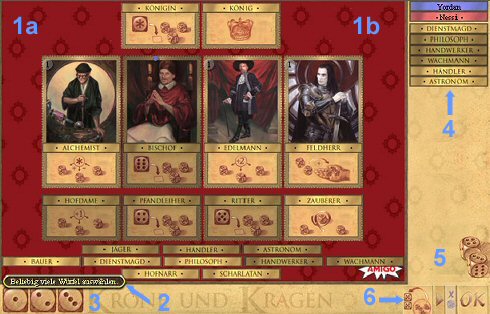
Above is the BSW Interface with the court laid out. You can display different information by pointing your mouse at different parts of the board. If you move your mouse up and down the rows, each will take centre stage in turn. Be careful not to move the mouse too fast, because the rows will move again before you've had a chance to see what is there:
(1a) If you move your mouse to the left of the chosen row, you will see what you need to aquire each card.
(1b) If you move your mouse to the right of the chosen row, you will see the abilities of the court cards.
(2) At the lower left edge of BSW board is the action announcement
(3) Below the action announcement are the dice you have already put aside
(4) At the upper right side of the BSW board the court cards. During your turn, court cards which have been used are darkened. If you move your mouse over the names of the fellow players, their court cards are shown. If you stop your mouse over a court card, a window opens showing its abilities.
(5) At the middle right are the active dice which can be affected by the court cards.
(6) Rolling and confirming actions are made in the very bottom right panel.
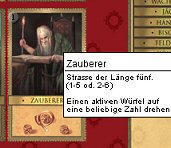
If you keep your mouse over a court card, a Tooltip appears that explains the name, the purchase price and ability of that card
The Game
Each turn you try to improve your position at the receiving more court cards. You must achieve the goal defined on the court card to aquire it. You must set aside at least one the each after throw, which you will use towards your acquistion of a Court Card. Once set aside it cannot be changed. During your turn you can use as many of your court cards as necessary in order to take advantage of the dice in play to convert them to meet your needs. Each card however may only be used Member per round.
Flow of the game
The starting player throws 3 dice. On the bottom right select the hand rolling dice icon and then OK.
Later on in the game you could if you wanted elect to play one or more of your Court cards before your first roll.
Highlight the die/dice you wish to set aside and click OK. Repeat this process (rolling/using Court cards/selecting) until you have set aside all of your dice.
How to use Court cards
To use your Court cards select the card you wish (located under your name on top right) and click it.

The action available will now be available on the bottom right. Select this option, select the/dice you wish to affect then click OK. (The die/dice wants turn green if you highlight them during this action). You can elect to play as many Court cards as and when you like during your turn but only once per turn. You do not have to play any or all of your Court cards in any given turn, including those that give you extra dice, except the Bauer and Feldherr, which are automatically used.

You can select between the roll/set aside functions by clicking on the appropriate button and then OK. You must always select at least one the to set aside.
Page not found
After each roll, you must select at least one die. It is, however, possible to change the die/dice value(s) or add a die/dice by use of court member card, before select. Re-roll the dice until all dice are selected and end up on the bottom left.
Acquiring court cards
Once you have set aside all your available dice you can now select any one Court card whose requirement is satisfied by the dice you set aside. The cards you can choose are lit up. Move over the rows, highlight an available card, then click OK. Your turn is now over.
Note: The number and quantity of available Court cards depends on the number of people playing so be careful otherwise the card you are seeking may have run out!
Play Sequence
Each round is played in a sense. After each round the start marker moves one space anti-clockwise, so that the last player one round is the first player the next round.
End of the Game
If you set aside 7 identical dice then you can take the Coward . This comes with the Konigin as well, which gives you the option to add 1 dice of any value. Once the Konig is taken, the current round is completed as usual, and then there is one final round. In the final round, each player tries to take the Konig from whoever it by beating the number of identical dice they rolled (or rolling the same number of identical dice but with a higher value). E.G. If a player took the Konig with 5s, then to take the Konig from them the next player has to roll seven 6s, or eight of any number. They do NOT get the Konigin. The person who took the Konig in the previous round plays last, and only has to EQUAL the current best roll to regain the Konig. Whoever poses the Konig card at the end of the game is the winner.
Final Round
The goal of the final turn is to acquire the king from other players and/or to defend against the acquisition. (The always queen remains in the player who first claims it.) Each player tries to accept the dice of the same value as many as possible. If tied, the value of the dice of the same child is the tie-breaker. If still tied, who first rolls search combination of dice keeps the king.

The highest score thus far is indicated against the corresponding player.
The player who acquired the king first has two advantages:
- The 6 of a kind or greater combination used to acquire the king counts as the highest score at the beginning of the final round. Other players need to score a higher combination of dice in order to claim the king.
- He has one final chance to score an even higher winning combinationEven he obtains the best dice combination and claim back the king if necessary.
Whoever poses the Konig card at the end of the game is the winner.
Courtyard
Row 0
Jester (Hofnarr)
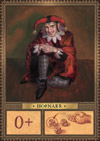
- Cost: Sum of all dice must be 0+
- Benefit: One active dice can be rerolled
Charlatan (Scharlatan)

- Cost: Must have a Hofnarr, and sum of all dice must be 0+. He wants replace the Hofnarr.
- Benefit: At the beginning of your turn, add one dice to your hand.
The Sharlatan replaces the Hofnar. If you have already converted a Hofnar into a Scharlatan, you may acquire another Hofnar as well.
Row 1
Farmers
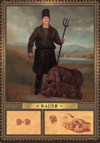
- Cost: A pair
- Benefit: At the beginning of your turn, add one dice to your hand.
Servant (service client)
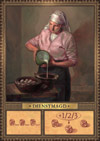
- Cost: All dice must be odd
- Benefit: To one active die, add 1, 2, or 3
Philosopher(Philosoph)

- Cost: All dice must be even
- Benefit: Subtract points from one die and add them to another.
Example: A player rolls 5-3-1 and uses the philosopher,to take 2 from the 5 and add them to the 1, giving a roll of 3-3-3.
Worker (Handwerker)
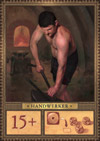
- Cost: Sum of all dice must be 15+
- Benefit: One die with a ‐1 is added to the active dice
Guard (Wachmann)
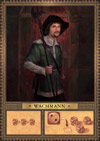
- Cost: Three of a kind
- Benefit: One die with a ¢2 is added to the active dice
Row 2
Hunter(Jäger)
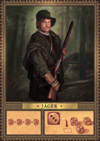
- Cost: Four of a kind
- Benefit: One die with a ‐3 is added to the active dice
Traders (traders)
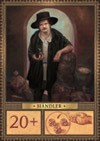
- Cost: Sum of all dice must be 20+
- Benefit: Roll any number of active dice again
Astronomer (Astronom)

- Cost: Two pairs
- Benefit: Change one active die to a number already set aside
Row 3
Lady in Waiting (Hofdame)

- Cost: Full House (three of a child and a pair)
- Benefit: Add +1 to any number of active dice
Pawnbroker (Pfandleiher)
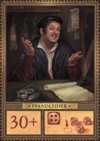
- Cost: Sum of all dice must be 30+
- Benefit: One die with a ‐4 is added to the active dice
Knight (Ritter)
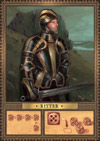
- Cost: Five of a kind
- Benefit: One die with a ‐5 is added to the active dice
Sorcererer
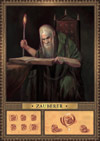
- Cost: Five dice straight (1-5 or 2-6)
- Benefit: Change one active die to any number
Row 4
alchemist
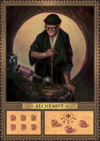
- Cost: Six dice straight (1-6)
- Benefit: Redistribute the points of two or three dice among themselves.
The interface for this is fiddly: First click the little 3-dice icon, and select the 3 dice to be changed; Next click the little 2-dice icon and select the first pairing from the 3 to be changed; Use the up/down arrows until you get the result you want from that pair; Repeat from click the little 2-dice icon until you are satisfied, then click OK
Example: A player rolls 6-2-1 and uses the Alchemist to subtract 3 from the 6, add 1 to the 2 and 2 to the 1, giving a roll of 3-3-3.
Bishop (Bishof)

- Cost: Three pairs
- Benefit: One die with a ‐6 is added to the active dice
Noble (Edelmann)

- Cost: Two threes of a kind
- Benefit: Add +2 to any number of active dice
General (Fieldlor)
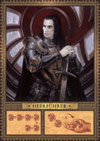
- Cost: Six of a kind
- Benefit: At the beginning of your turn, add two dice to your hand
Row 5
Queen (King)
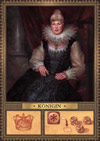
- Cost: First player with seven of a kind takes the Konig (and triggers the final turn at the end of the current turn), and gets the Konigin to keep, even if they later lose the Konig
- Benefit: Add a die with any number to the active hand
King (King)
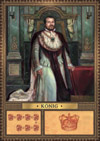
- Cost: Highest seven of a child so far takes the Konig from its current owner
- Benefit: Owner of the Konig at the end of the game is the winner
Distribution of Cards
The number of available Court cards depends on the number of people
| Courtyard | # Players | |||
|---|---|---|---|---|
| 2 | 3 | 4 | 5 | |
| Row 5 (Queen, King) | 1 | 1 | 1 | 1 |
| Row 4 (Alchemist, Bishop, Noble, General) | 1 | 2 | 2 | 3 |
| Row 3 (Lady in Waiting, Pawnbroker, Knight, Sorcerer) | 1 | 2 | 2 | 3 |
| Row 2 (Hunter, Merchant, Astronomer) | 1 | 2 | 3 | 3 |
| Row 1 (Farmer, Servant, philosopher, worker, guard) | 2 | 2 | 3 | 4 |
| Row 0 (Jester, Charlatan) | 2 | 3 | 4 | 5 |
Tactics
- You should try to get as many extra dice as you can, especially at the beginning of the game.
- You should therefore obtain some of the special change cards but keep an eye on the other players as they may become king and start the end game!
Example gameplay:
A player has the Bauer, the Craftsman, the Edelmann and the Astronomer in his hand. The Bauer gives +1 the at the beginning of the round. The roll is say 1-3-3-6 (with an additional die). He decides to add a "1" using his craftsmen. So he decides to use his Edelmann and add +2 to the existing 2 "1"s. He now has 3-3-3-3-6. He selects to keep the 4 "3"s and then uses his Astronom to convert the other die into a 3 and elects to keep it. He now has 3-3-3-3-3 and can therefore acquire the knight.

